Extensive literature reports an increase in physical disorders (pain, pathologies, dysfunctions) and mental malaise/uneasiness (stress, burnout) affecting dental professionals in relation to fast and pressing rhythms of work, long working hours, increasingly demanding patients, ever-evolving technologies, etc. This project has been conceived to bring the science of yoga around the world to dental professionals as a preventive (occupational) medicine and to provide knowledge and means for self-care. Yoga is a concentrative self-discipline of the mind, senses, and physical body, that requires regular daily exercise (or meditation), attention, intention, and disciplined action.
M&M: The study aimed to design a Yoga protocol specifically devised for dental professionals (dentists, dental hygienists, and dental assistants) including positions (
āsana) to be practiced/used in the dental office. The protocol is targeted for the upper body, namely neck, upper back, chest, shoulder girdle, and wrists, being areas greatly affected by work-related musculoskeletal disorders. This paper represents a yoga-based guideline for the self-cure of musculoskeletal disorders among dental professionals.
Results: The protocol includes both sitting (
Upavistha position) and standing (
Utthana or
Sama position)
āsana, with twisting (
Parivrtta), side bending (
Parsva), flexion and forward bending (
Pashima), and extension and arching (
Purva)
āsana to mobilize and decompress, and to provide nourishment and oxygen to the musculo-articular system. The paper delivers different concepts and theories developed and deepened by the authors and introduces and spreads yoga as a medical science among dental professionals for the prevention and treatment of work-related musculoskeletal disorders. We articulate notions ranging from stretching out using the
vinyāsa method (breath-driven movement) and inward-focused attention to contemplative/concentrative science, interoceptive attention, self-awareness, the mind–body connection, and receptive attitude. The theory of “muscles are bone ties” is coined and delivered with regard to tensegrity musculoskeletal fascial structures connecting, pulling together, and nearing the bone segments where they are anchored. The paper describes over 60
āsana envisaged to be performed on dental stools or using the walls of a dental office or a dental unit chair. A detailed guideline on the work-related disorders that can find relief with the protocol is provided, including the description of breath control for the practice of
āsana in
vinyāsa. The foundations of the technique reside in the
Iyengar Yoga method and
Parināma Yoga method.
Conclusions: This paper represents a guideline for self-cure in the prevention or treatment of musculoskeletal disorders affecting dental professionals. Yoga is a powerful concentrative self-discipline able to provide physical and mental well-being, representing great help and support in daily life and business for dental professionals.
Yógāsana restores retracted and stiff muscles, giving relief to the strained and tired limbs of dental professionals. Yoga is not intended for flexible or physically performing persons but for people who decide to take care of themselves. The practice of specific
āsana represents a powerful tool for the prevention or treatment of MSDs related to poor posture, forward head, chronic neck tension (and related headache), depressed chest, compressive disorders on wrists and shoulders as carpal tunnel, impingement syndromes, outlet syndrome, subacromial pain syndrome and spinal disc pathologies. Yoga, as an integrative science in medicine and public health, represents a powerful tool for the prevention and treatment of occupational musculoskeletal disorders and an extraordinary path for the self-care of dental professionals, sitting job workers, and healthcare providers suffering from occupational biomechanical stresses and awkward postures.
Full article






